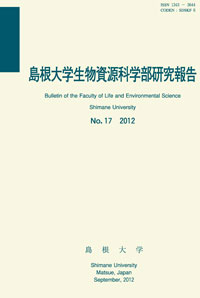島根大学生物資源科学部
ISSN:2435-0885(online)
ISSN:1343-3644(in print)
A publication of this bulletin in print format has not been made since no 24.
ISSN:1343-3644(in print)
A publication of this bulletin in print format has not been made since no 24.

number of downloads : ?
Use this link to cite this item : https://ir.lib.shimane-u.ac.jp/5651
Bulletin of the Faculty of Life and Environmental Science Shimane University 9
2004-08-31 発行
幼穂の発育に及ぼす温度の影響
Effects of Temperature on the Development of Rice Panicles
File
Description
The relationship between temperature and spikelet number per panicle in rice was examined. Two experiments were conducted: Experiment 1)a treatment of air temperature(AT)and Experiment 2)a treatment of water temperature(WT). In experiment1, three regimes of AT were applied: High temperature,32/24℃(day/night); Medium temperature,29/21℃; Low temperature,26/18℃. In Experiment 2, three levels of WT(26,29,32℃)were applied in day. WT at night was not controlled independently from the AT. Dry weights were measured at the stage of spikelet differentiation. At heading, dry weights and the number of differentiated spikelets and primary and secondary rachis-branches per panicle were measured. High AT during the early reproductive stage reduced the number of differentiated spikelets. High AT did not decrease dry matter accumulation, but changed the allocation of dry matter among organs. High AT promoted dry matter accumulation to leaves, but decreased dry matter accumulation to tillers. Low WT increased the number of differentiated spikelets, but decreased the number of surviving spikelets through increasing of spikelet degeneration. The WT treatment little affected dry matter accumulation and partitioning among organs. 13C atom percents in leaf blades and leaf sheaths at heading were higher than those in panicles, which result suggested that carbohydrates assimilated at the stage of spikelet differentiation were translocated into actively growing organs such as leaves prior to young panicles. The role of temperature in spikelet differentiation was discussed.
About This Article
Other Article
PP. 13 - 21
PP. 41 - 49
